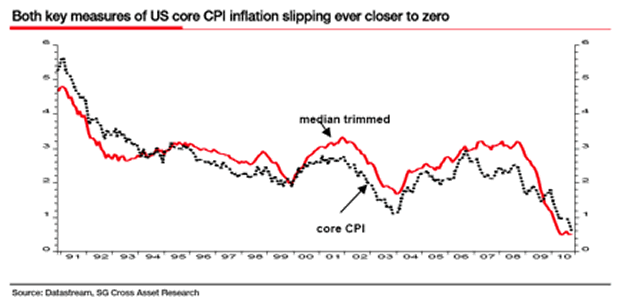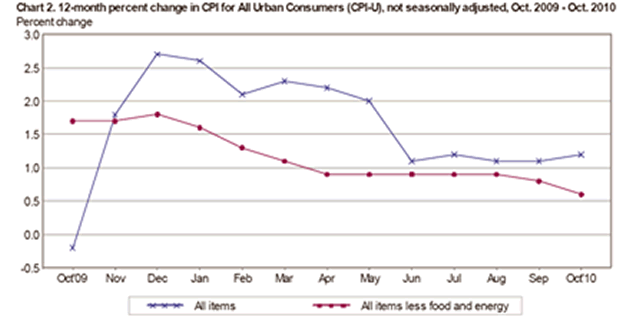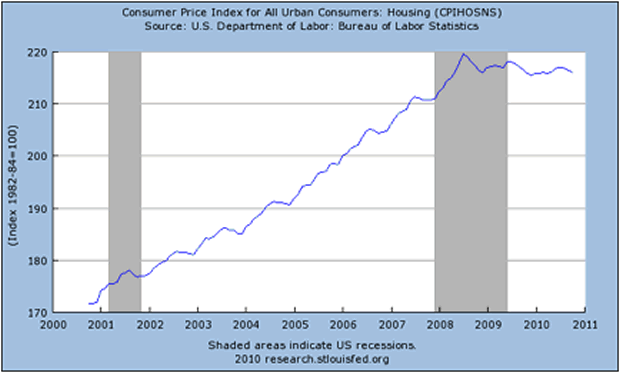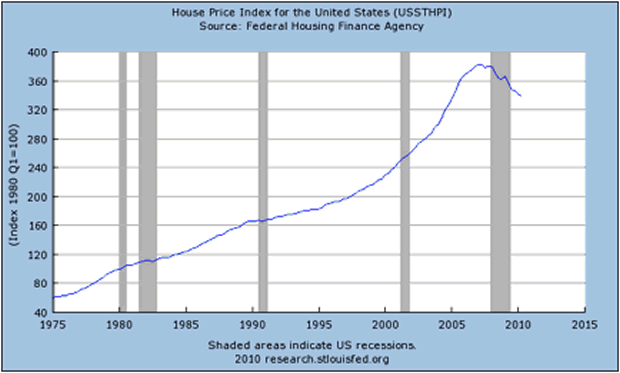The Sputtering U.S. Economy, Deflation Exactly Where is it?
Economics / Deflation Nov 20, 2010 - 11:47 AM GMTBy: John_Mauldin
 The Sputtering Economy
The Sputtering Economy
Old and Outmoded
We Have Deflation Exactly Where?
O Deflation, Where is Thy Sting?
The CPI was out this week, and it showed a continued drop in inflation. There were those who immediately pointed out that this vindicated the Fed's move to QE2. We have to get ahead of this deflation thing, don't we? Well, maybe, depending on how you measure inflation/deflation. This week we look deep into the BLS website on inflation to see just exactly what it is we are measuring, and then take a walk down Nostalgia Lane. But first we look at what I think we can call The Sputtering Economy, because that will tie into our inflation discussion.
The Sputtering Economy
My father, who would be 100 this summer, would hitch up the wagon on a farm in Castleberry, Texas, about 6 miles from downtown Fort Worth, to drive to church or to the Big City for supplies. He was 57 when they put a man on the moon. It was hard for me as a kid to relate to wagons and outhouses, although we grew up rather poor on the outskirts of a very small town on the edge of West Texas, living as country kids. It was a great life. We were all poor and didn't know it.
My kids have some of the same issues about understanding my early era. I grew up as we were first starting to get power lawn mowers, a dream for me, as I hated push mowers and slings. But you had to constantly tinker with them. Neglect them for too long and they would start to sputter. When that happened, you first looked at the spark plugs, then the carburetor and the gas/air mix, filters, etc. And as I got older, that helped with my transition to taking care of my car. I was not a great mechanic but, as nearly everyone was, I was adequate.
Today? I can't even figure out what is under the hood. No clue. And my tools back in 1967? Not designed for a 2010 model, let alone a hybrid.
Same with our old black and white TV of the late '50s. As a ten-year-old kid, when the TV went out I would take off the back of the set, take out every one of the 20 or so vacuum tubes, and test them all. You wanted to test them all because if more than one was bad it was two miles to the store on my bike, and it was uphill at least one way. Those old tubes went out all the time. Just part of the price of watching TV.
Our economy today is like that old lawn mower engine. We get one piece of economic data that is good to very good, and the next day we get some bad news. Let's look at some of the data for the past few weeks.
Last week we got the New York Fed Empire Index. It was simply ugly. It fell from 15.7 to a -11.4. But then this week we get the Philly Fed Index, and it's shockingly high. The consensus saw a mild increase to an index level of 5, but it jumped 21 points to 22.5. And all the underlying components were very solid. It is hard to square such a difference when the cities that spawned these reports are about an hour train ride apart.
Capacity utilization is slowly rising, but is still at a recession level 72.7%, up 4 points from 12 months ago and the highest since over two years ago. So are we getting better or are we still mired in the doldrums? I think the answer depends on how many hours you are working.
The surveys from the National Federation of Independent Business continue to indicate that small businesses are not out of the woods. Hiring is at a virtual standstill but is at least not falling, as it was most of this year and last year. Business conditions are mixed. The survey is better than it was but still shows a sputtering economy.
The latest establishment employment survey shows job growth, though not at a level that can bring down the unemployment level. And if you look at the household survey, two things leap out. First, there is a significant rise in the number of people employed part-time. The rise in employment is not of a sort that prompts a sigh of relief. Part-time work, while better than none, does not inspire consumer confidence. It is not the fabric of a solid recovery.
Second, there are not many small business start-ups, which are the source, the feedstock if you will, of job growth. Whether because it is harder than ever to find money (it is) or because entrepreneurs are uncertain about what the future holds (they are), or for whatever reason, that is a very troubling metric. And the household survey showed a large decrease in the numbers of jobs and people working, a different story than the establishment survey.
What it all suggests is an economy growing between one and two percent. That is better than recession but not good enough to really bite into the unemployment rate.
Old and Outmoded
And that could mean trouble, as there are millions of people who are coming to the end of their 99-week extended unemployment benefits this next year. Although Congress rejected an extension this week, it was on a vote that required a 2/3 majority. That bill will be back as one that only needs a simple majority, and then it will be up to the Senate. Even so, as I understand it, benefits will only get extended for three months. At least that is the current plan. Already, people are running out of their extended benefits. Earlier this year there were 12 million people on the extended and regular unemployment rolls. That is dropping each week and is now down to 8,854,206 people, according to the DOL. Since the regular continuing claims number is not really changing all that much, much of it is from people dropping off the rolls.
And the number of people on food stamps continues to rise. As of the end of August, when continuing benefits were running over 10M, a total of 42,389,619 people were receiving food stamps under the SNAP program. This was an increase of 553,379 people over July's number, or an increase month-over-month of 1.32%. The year-over-year increase was 6,147,762 people or 17%. In July the increase was 17.51%.
Now here's an interesting thing my friend John Vogel noticed. Households on food stamps are growing even faster than the number of individuals on food stamps. In August, 19,720,255 households were on food stamps, an increase of 284,877 households over the July numbers. This was a percentage increase of 1.47%. In terms of a yearly increase, the number of households grew by 3,159,502 or 19.1%, versus 19.53% recorded in July. As John wrote me:
"So, the numbers keep growing strongly, with households growing more rapidly than people. This still signifies more childless couples or single people being affected lately.
"I cannot figure this out yet, but I feel that we are going through a very significant change in household formation, in the type and quantity of available jobs, in small business stability and formation - and we are applying old, outmoded macroeconomic solutions to problems that will not and cannot respond."
We'll come back to that thought, but first we have to look at the definition of deflation.
We Have Deflation Exactly Where?
President Clinton famously remarked about his escapades that "... it all depends on the definition of what is is." And similarly, whether or not we are in danger of deflation all depends on what your definition of deflation is. First, let's look at the recent headline numbers. What we find is that core inflation, at 0.6%, as well as trimmed inflation (which takes out the statistical outliers and anomalies) are both at post-war all-time lows.

Another way to look at inflation is all-items inflation vs. core inflation, that is, inflation without food and energy. From the BLS website:

I have often joked that when you become a Fed governor they take you into a back room and do a DNA change on you. When you come out you are at all times and everywhere viscerally opposed to deflation. You will not let it happen on your watch.
And that is what happened in 2003, as deflation became a concern. The Fed under Greenspan allowed interest rates to stay low "for an extended period of time" in order to make sure deflation did not take root. Notice that it was in late 2002 that Bernanke gave his famous "helicopter" speech on deflation. There was very real concern in policy circles.
But should there have been? What if the way we measured inflation was flawed in some regard? Let's play a thought game. Back in the early '80s there was some consternation about using the price of houses as a way to calculate inflation. Read this paragraph from the BLS website (emphasis mine):
"Until the early 1980s, the CPI used what is called the asset price method to measure the change in the costs of owner-occupied housing. The asset price method treats the purchase of an asset, such as a house, as it does the purchase of any consumer good. Because the asset price method can lead to inappropriate results for goods that are purchased largely for investment reasons, the CPI implemented the rental equivalence approach to measuring price change for owner-occupied housing. It was implemented for the CPI-U in January 1983."
Homeowner equivalent rent is 25.2% of the input when they calculate the Consumer Price Index (CPI). Thus it makes a big difference how you calculate the price of housing. It is extraordinarily difficult to find historical data on homeowner equivalent rent in the BLS database. You can find "shelter costs," which include energy, insurance, etc. and are 41% of the CPI, but for our purposes today I want to focus more narrowly.
I did find an old release that shows the index value for the year 2000 to be 198.7 (http://www.bls.gov/cpi/cpid00av.pdf). The index value as of this October was 256.8. That means the rise in housing costs over the last decade was about 25% or roughly 2.5% a year, although in the last few years that number has gone deadline flat. And you can see that in the graph of total housing costs below.

But house prices went up by more than double that amount, and about 65% in the seven years from 2000 to 2007 (back-of-the-napkin estimate). That is an asset inflation of about 9-10% a year.

What if we had been using actual home prices as the measure of inflation? Let's look at the year-over-year change in inflation for the last ten years:
Homeowners equivalent rent is 25% of the index. So take the home price rise, divide it by four, and add it to the inflation index. Inflation in the middle of the decade would have been running 4-5-6% and in 2005 would have been over 7%!
Would rates have been kept low "for an extended period of time" if we had still been using actual home prices? I rather doubt it - alarms bells would have been sounding. The Fed would have been leaning into the rise in "inflation." Thus no housing bubble would have developed. And then no credit crisis.
And the difference all stems from how you measure inflation. These details matter. Now, let's go back to that highlighted portion from the BLS web site.
"Because the asset price method can lead to inappropriate results for goods that are purchased largely for investment reasons [emphasis mine], the CPI implemented the rental equivalence approach to measuring price change for owner-occupied housing."
In the 1980s the BLS (under Reagan, so not a liberal plot!) decided a home was an investment and not a roof over our head. It also conveniently allowed for lower official inflation, which is what Social Security and other government programs are tied to. But that change had significant unintended consequences.
O Deflation, Where Is Thy Sting?
Now, if you have no social life (at least on Fridays, when I write) you can go to the BLS website and get a plethora of data. (I bet that breakout of HOER is somewhere there, I just can't find it, and their search engine needs an update.) One of the things they do is offer all sorts of ways to look at inflation, way down the page (http://www.bls.gov/news.release/pdf/cpi.pdf).
First, we find that inflation for all items is 1.2% over the last year. All items less food and energy, or core inflation (which the Fed pays attention to), is only 0.6%. That is getting dangerously low, isn't it?
Maybe not. What you find is that inflation when you take out housing costs is a jaunty 1.9%. Right in the Fed target range of 1.5-2%. Even "core" inflation, when you take out housing, is 1.5%. That is not exactly something we should be worried about. That flat equivalent-rent number is showing a deflation risk that is simply not there.
But the Fed is worried about deflation and other things, so they are going to embark on a $600-billion quantitative easing, which among other things is going to help devalue the dollar and has already caused a rise in commodity, energy, and food prices.
We may in fact get some inflation, but precisely where we do not want it. While the Fed may prefer to look at core inflation, the rest of us live in a world where we buy food and consume energy. And for those in the lower part of the income spectrum, the rising cost of food and energy is disproportionately high. It acts like a tax on disposable income, which will hurt retail sales, which is PRECISELY what we do not need.
And all because we have the hubris to think we can measure inflation in some precise manner, and then choose policies to react to our imprecision.
Remember my 1967 tools? They wouldn't do me much good if I had to try and fix my car today. Not that if I were in the desert and my car broke down I might not try. It is after all still an engine, and somewhere in there must be something I can understand.
I wonder if the Fed is not trying to fix a modern 2010 economy with tools made in the '50s, based on theories based in the writings of a bunch of dead white guys. They were smart guys, I give you that. But times have changed. And our measurement tools seem flawed to me.
Thankfully, I rather think that the $600 billion can be absorbed without too much collateral damage. We do have a large economy, and the multiplier effect is at an all-time low. Or maybe I am just guilty of wishful, optimistic thinking.
Finally, this thought on what we can do to shore up home prices, from one of my favorite thinkers on the housing market, John Burns. Now here is a program that would work and also save taxpayers money. (http://www.realestateconsulting.com/content/our-proposed-rental-solution)
"Proposed Rental Housing Solution: Falling home prices don't help anyone, and anyone who says we can let the free market take care of things is saying that it is ok for taxpayers and the banking system to lose many more billions of dollars, virtually assuring another recession and maybe worse. To boost housing demand and limit supply, we propose the following:
"1) Create an Apartment REIT: Distressed sales need to be kept off the market. Rent out the Fannie, Freddie and FHA REO (owned properties through foreclosure). These properties currently comprise 42% of the 562,000 REO and a large percentage of the 5.1 million homes currently in the foreclosure pipeline (already 90+ days delinquent or in foreclosure). This is best accomplished by contracting with an outside firm (competitively bid of course) to manage local property management firms. The rental income will be self-sustaining and the properties will be financeable in the public markets, just like publicly traded REITs are financeable. The GSEs will benefit from future price appreciation too, as opposed to being damaged by further price deterioration. The Banks, who currently own 22% of the REO, should also be allowed to contribute properties to the REIT. The Administration can keep pushing for loan mods if they want, and we heard over and over again how government doesn't want to foreclose on people. All we ask is that you keep the distressed sales off the market.
"2) Loans to Landlords: To stimulate demand and restrict supply on non-GSE distressed sales, have the GSEs make very safe loans to individuals or corporations who will promise to rent them out for an extended period of time. The GSEs should make a tidy profit on these loans, while also helping provide affordable rental housing to those who need it.
"3) Keep Mortgage Liquidity Flowing: Housing is extremely affordable right now, but the uncertainty in the mortgage industry is making underwriting more challenging, and uncertainty in the economy is hurting buyer confidence. Stop changing the underwriting rules so everyone knows what is required, and keep the fantastic financing environment. Once the economy turns around, real buyers will return to the market. We believe that the solutions above will also help restore home buyer confidence that prices won't plunge, which will boost demand."
Mexico, High Noon, and Thanksgiving
I was sitting in my office late last night. I had gotten an e-letter from my good friend Doug Casey, one of his occasional "Conversations." In this one he decided to talk about music. I almost deleted it (music recommendations from Doug Casey? Gold mining stocks, maybe). But then I saw one song I had not thought of for years, and he had a link to a YouTube site where I could hear it. And then another and another. It seems Doug and I, both being of a certain age, grew up with the same music. It was late and I was in the house alone, so I turned up the speakers, poured some scotch, and went back down Nostalgia Lane.
He even mentioned Frankie Lane, and there was a link to the theme song from High Noon, which of course made me go to the original by Tex Ritter. About that time, my middle son, Chad, age 22, slipped into the room and scared the life out of me. After I recovered he asked me what in the world I was listening to. I found out, to my great shame as a derelict Dad, that he had never seen High Noon. I asked Tiffani, my oldest. No. Somehow my kids left home without ever seeing High Noon.
Really. How can you understand my father's generation or how they shaped us without understanding the era that could make a High Noon? Once your kids are grown, there is not much that you can do to make up for what you didn't do when they were in your hands. But I can change this one thing. When they are all home for Christmas, the only thing I want is for us all to sit down with Gary Cooper and Grace Kelly and watch High Noon and then talk about it. Now that will be a real present. And then, as we normally do, we can go watch a new movie. (There is a great DVD of High Noon at Amazon.com)
This week is Thanksgiving, and it looks like it will be crowded at the Mauldin home, with maybe some 30-odd (in some cases the right word) people. Seems someone wants to invite someone who has a friend, and it just grows. And it gets to be more fun. I love to cook, and this is one of those days when I pull out all the stops. My prime rib is the best ever and my mushrooms are to die for. As is everything at Thanksgiving. It seems everyone brings the things they are best at, and so we all feast.
Sunday, Tiffani and Ryan and I leave for LA and the Forbes Cruise down to Mexico. I am really looking forward to it.
Have a great week. If you are in the US, enjoy Thanksgiving. Spend it with friends and family and pause for a few moments to count all your blessings. And remember those in harm's way who make it possible.
Your thinking about how fast the years have gone by analyst,
John F. Mauldin
johnmauldin@investorsinsight.com
John Mauldin, Best-Selling author and recognized financial expert, is also editor of the free Thoughts From the Frontline that goes to over 1 million readers each week. For more information on John or his FREE weekly economic letter go to: http://www.frontlinethoughts.com/learnmore
To subscribe to John Mauldin's E-Letter please click here:http://www.frontlinethoughts.com/subscribe.asp
Copyright 2010 John Mauldin. All Rights Reserved
Note: John Mauldin is the President of Millennium Wave Advisors, LLC (MWA), which is an investment advisory firm registered with multiple states. John Mauldin is a registered representative of Millennium Wave Securities, LLC, (MWS), an FINRA registered broker-dealer. MWS is also a Commodity Pool Operator (CPO) and a Commodity Trading Advisor (CTA) registered with the CFTC, as well as an Introducing Broker (IB). Millennium Wave Investments is a dba of MWA LLC and MWS LLC. Millennium Wave Investments cooperates in the consulting on and marketing of private investment offerings with other independent firms such as Altegris Investments; Absolute Return Partners, LLP; Plexus Asset Management; Fynn Capital; and Nicola Wealth Management. Funds recommended by Mauldin may pay a portion of their fees to these independent firms, who will share 1/3 of those fees with MWS and thus with Mauldin. Any views expressed herein are provided for information purposes only and should not be construed in any way as an offer, an endorsement, or inducement to invest with any CTA, fund, or program mentioned here or elsewhere. Before seeking any advisor's services or making an investment in a fund, investors must read and examine thoroughly the respective disclosure document or offering memorandum. Since these firms and Mauldin receive fees from the funds they recommend/market, they only recommend/market products with which they have been able to negotiate fee arrangements.
Opinions expressed in these reports may change without prior notice. John Mauldin and/or the staffs at Millennium Wave Advisors, LLC and InvestorsInsight Publishing, Inc. ("InvestorsInsight") may or may not have investments in any funds cited above.
Disclaimer PAST RESULTS ARE NOT INDICATIVE OF FUTURE RESULTS. THERE IS RISK OF LOSS AS WELL AS THE OPPORTUNITY FOR GAIN WHEN INVESTING IN MANAGED FUNDS. WHEN CONSIDERING ALTERNATIVE INVESTMENTS, INCLUDING HEDGE FUNDS, YOU SHOULD CONSIDER VARIOUS RISKS INCLUDING THE FACT THAT SOME PRODUCTS: OFTEN ENGAGE IN LEVERAGING AND OTHER SPECULATIVE INVESTMENT PRACTICES THAT MAY INCREASE THE RISK OF INVESTMENT LOSS, CAN BE ILLIQUID, ARE NOT REQUIRED TO PROVIDE PERIODIC PRICING OR VALUATION INFORMATION TO INVESTORS, MAY INVOLVE COMPLEX TAX STRUCTURES AND DELAYS IN DISTRIBUTING IMPORTANT TAX INFORMATION, ARE NOT SUBJECT TO THE SAME REGULATORY REQUIREMENTS AS MUTUAL FUNDS, OFTEN CHARGE HIGH FEES, AND IN MANY CASES THE UNDERLYING INVESTMENTS ARE NOT TRANSPARENT AND ARE KNOWN ONLY TO THE INVESTMENT MANAGER.
John Mauldin Archive |
© 2005-2022 http://www.MarketOracle.co.uk - The Market Oracle is a FREE Daily Financial Markets Analysis & Forecasting online publication.



